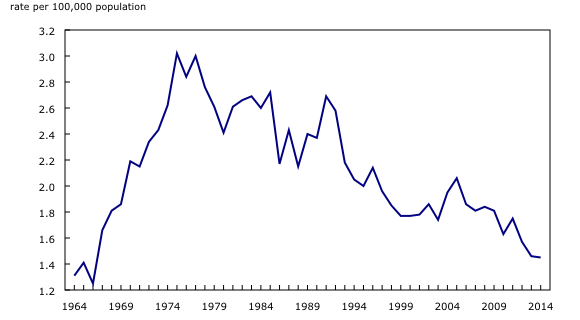
THUNDER BAY – Statistics Canada reports that there were 516 reported homicides in Canada during 2014. While Thunder Bay, during 2014 saw an increase in the number of murders, the overall trend in Ontario was downward. There were thirteen fewer homicides in Ontario. Thunder Bay saw a homicide rate three times greater than the rate for the second place community, Winnipeg. There were 9.04 homicides in Thunder Bay per 100,000 population.
The Agency states that “Canadian police services reported 516 homicides in 2014, 4 more than in the previous year. The homicide rate, however, was stable in 2014 (1.45 per 100,000 population), making 2013 and 2014 the years with the lowest homicide rates since 1966.”
Almost a quarter (23%) of those 516 homicide victims were reported by police as Aboriginal, a group that accounted for just 5% of the Canadian population.
In 2014, five provinces reported fewer homicides compared with 2013: Ontario (-13), Nova Scotia (-7), Saskatchewan (-7), Manitoba (-7) and Newfoundland and Labrador (-5).
The decline in Nova Scotia resulted in the lowest rate ever reported for that province since the Homicide Survey began collecting data in 1961.
Seven jurisdictions reported more homicides: Alberta (+22), British Columbia (+12), Yukon (+3), Prince Edward Island (+2), New Brunswick (+2), Quebec (+1) and Northwest Territories (+1). The number of homicides in Nunavut was unchanged.
Despite the additional homicide in Quebec in 2014, the homicide rate was unchanged from the previous year and was the lowest since 1966.
Manitoba continues to have the highest provincial homicide rate
Despite a 15% decline in 2014, Manitoba continued to have the highest homicide rate among the provinces for the eighth year in a row. Manitoba reported 3.43 homicides per 100,000 population, followed by Alberta (2.52 per 100,000) and Saskatchewan (2.13 per 100,000).
Newfoundland and Labrador (0.38 per 100,000 population) and Nova Scotia (0.64 per 100,000 population) had the lowest provincial rates.
Historically, the territories have had the highest rates in Canada. However, because of small numbers, there is large variability from year to year. In 2014, with 4 homicides, Nunavut reported the highest homicide rate nationally at 10.93 per 100,000 population.
Thunder Bay reports unusually high number of homicides in 2014
Among Canada’s 34 census metropolitan areas (CMAs), 14 reported an annual decline in their homicide rate, another 14 reported an increase and 6 were unchanged.
With an above average number of homicides reported in 2014, Thunder Bay (11) had the highest homicide rate among Canada’s CMAs. At 9.04 per 100,000 population, Thunder Bay’s rate was nearly three times that of Winnipeg, which recorded the second highest rate (3.29 per 100,000 population).
With a 51% decrease in its rate, Regina went from having the highest homicide rate in 2013 to eighth highest in 2014.
No homicides were reported in Saguenay, Sherbrooke, Kingston, Oshawa and Brantford in 2014.
Firearm-related homicides increase
Police reported 156 firearm-related homicides in 2014, 21 more than in 2013, representing a 14% increase in the rate of firearm-related homicides. Despite this increase, the rate of firearm-related homicide was the second lowest recorded since data became available in 1974.
Handguns remain the most frequently used type of firearm and were involved in approximately two-thirds of firearm-related homicides in 2014.
Most victims knew the accused
As was the case in previous years, most solved homicides in 2014 were committed by someone known to the victim (83%).
Victims were most often killed by an acquaintance (37%) or a family member (34%) in 2014, including current or ex-spouses (16%). In addition, victims were killed by someone known through criminal relationships (6%) or by someone with whom they had a non-spousal intimate relationship (5%).
In 2014, there were 83 intimate partner homicides in Canada, 11 more than in 2013. The rate of intimate partner homicides was four times greater for females than for males. Intimate partner homicides include those committed by a current or former legally married or common-law spouse, boyfriend/girlfriend, or other intimate relationship.
For the first time, complete Aboriginal identity data have been reported
The year 2014 marks the first year the survey has had complete police-reported data on the Aboriginal identity of victims and people accused of homicide. As well, police-reported data on the Aboriginal identity of female homicide victims is now available from 1980 to 2013.
Almost one-quarter of homicide victims are Aboriginal
In 2014, 117 of the 516 homicide victims, or 23%, were reported by police as Aboriginal. In contrast, Aboriginal people accounted for just 5% of the Canadian population.
Aboriginal people were victims of homicide in 2014 at a rate that was about six times higher than that of non-Aboriginal people (7.20 victims per 100,000 Aboriginal people versus 1.13 victims per 100,000 non-Aboriginal people).
Aboriginal males were at the greatest risk of being victims of homicide. Aboriginal males were seven times more likely to be homicide victims compared with non-Aboriginal males (10.86 per 100,000 population versus 1.61) and three times more likely than Aboriginal females.
The rate of homicide for Aboriginal females was six times higher than for their non-Aboriginal counterparts (3.64 per 100,000 versus 0.65).
Homicide rate for Aboriginal people highest in Manitoba and the territories
Among the provinces, the rate of homicides involving Aboriginal victims was highest in Manitoba (13.29 per 100,000), followed by Alberta (11.55 per 100,000). All three territories also reported high rates of homicide for Aboriginal peoples. The lowest rates were reported by Quebec (2.24) and Nova Scotia (2.56).
There were no Aboriginal homicide victims reported in 2014 for Newfoundland and Labrador, Prince Edward Island and New Brunswick.
The overrepresentation of Aboriginal people as homicide victims was greatest in Manitoba, where the rate was nine times higher than the rate for non-Aboriginal people (13.29 per 100,000 versus 1.41). This was followed by Nova Scotia, Ontario and Alberta, where the rates were six times higher, and Saskatchewan where the rate was five times higher.
The majority of homicides of Aboriginal people were solved
In 2014, a higher proportion of homicides of Aboriginal victims were solved by police compared with non-Aboriginal victims (85% versus 71%). As with non-Aboriginal victims, the majority of solved Aboriginal homicides were perpetrated by someone known to them (81% and 87%, respectively).
Spousal homicide was more common among non-Aboriginal female victims than their Aboriginal counterparts. While 45% of non-Aboriginal female victims were killed by a current or previous spouse (including common-law), the same was true for one-third of Aboriginal female victims.
The incidence of homicide by other family members was more common among Aboriginal female victims compared with non-Aboriginal victims (38% compared with 23%). Acquaintance homicide was more common among non-Aboriginal female victims than Aboriginal female victims (14% versus 8%), while stranger homicide was similar between the two (5% versus 4%).
The extent of spousal homicide for Aboriginal male victims was higher than for non-Aboriginal male victims (9% compared with 1%).
One-third of people accused of homicide were Aboriginal
Of the 431 persons accused of homicides in 2014, almost one-third (32%) were Aboriginal. The rate of Aboriginal people accused of homicide in Canada was 10 times higher than the rate for non-Aboriginal people (8.55 accused per 100,000 population compared with 0.82 per 100,000 population).
Aboriginal people accounted for 30% of males accused of homicide in 2014 and 51% of females accused.
Number of Aboriginal female victims relatively unchanged from 1980 to 2014, while declining for non-Aboriginal females
From 1980 to 2014, police services across Canada reported 6,849 homicides involving female victims. For that same period, Aboriginal female victims accounted for 16% (1,073) of all female victims of homicide.
Over the past 34 years, the number of Aboriginal female victims has remained relatively stable. In contrast, the number of non-Aboriginal female victims peaked in 1991 and has been declining since then, a pattern that follows the national trend. As a result, Aboriginal females account for an increasing proportion of total female victims. For instance, in 1991, Aboriginal females accounted for 14% of all female victims of homicide, compared with 21% in 2014.






